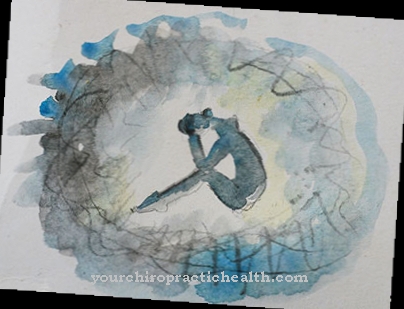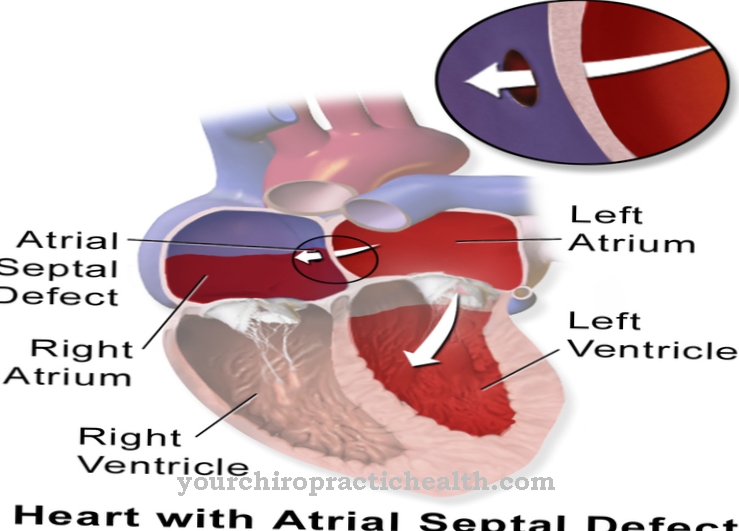Under one Pseudarthrosis medicine understands the failure to heal a broken bone from which a false joint develops. It usually causes severe pain and restricted mobility. The therapy depends on the exact form of the pseudarthrosis, and good prognoses can always be given.
What is pseudarthrosis?

© GraphicsRF - stock.adobe.com
The term Pseudarthrosis is made up of the Greek words "pseudes" and "arthros" and means something like "wrong joint". The terms sham joint, pseudo-joint or false joint are used synonymously for pseudarthrosis.
The disease is diagnosed if there is no healing six months after a bone fracture or surgical osteotomy. Before that, after four to six months without sufficient healing, one speaks of delayed fracture healing.
The medic distinguishes them vital pseudarthrosis of the avital pseudarthrosis. In the latter, the fracture is unstable, insufficiently supplied with blood and the surrounding tissue is inflamed or dead. In vital pseudarthrosis, the tissue is still well supplied with blood, but the break is also unstable.
causes
The causes of the Pseudarthrosis lie in insufficient healing of broken bones.
Shaft fractures of long tubular bones, for example the lower and upper thighs and the upper and lower arm, are particularly prone to pseudarthrosis. The false joint often occurs as a complication of a scaphoid fracture. Specifically, a distinction must be made between mechanical and morbid causes of pseudarthrosis.
Mechanical causes are the displacement of soft tissues in the fracture region, the displacement of the fracture ends against each other, insufficient care of the fracture with insufficient compression of the wound and too early mobilization of the fracture.
The morbid causes include excessive, but incorrect, bone healing, the callus, tissue loss due to insufficient patient care or insufficient blood supply to the wound, infections and systemic diseases. Patients with diabetes mellitus or arterial diseases are particularly affected. Less often, the risk of the disease is innate.
Symptoms, ailments & signs
Pseudoarthrosis can develop if the fracture sites do not heal adequately after a bone fracture. In such a case there is a discontinuity, a disturbance in the healing tissue. Shaft bones such as the thigh, ulna, radius and upper arm are very susceptible to this.
A wide variety of features indicate a pseudoarthrosis. If a bone heals relatively slowly after a fracture, this can be the first sign. If the healing does not start within six months, one can speak of a pseudoarthrosis. The disease usually develops slowly. The symptoms therefore continue to be delayed.
The first signs of pseudoarthrosis are primarily pain. Often these only occur under stress at the beginning of the disease. Chronic pain may develop later when the patient is at rest. Restrictions of movement and a reduction in strength are also typical for this clinical picture. Conversely, hypermobility and instability can also be signs of pseudoarthrosis.
Because the stability of the bone is sometimes greatly reduced, an axis deviation of the bone can develop. This is partially visible. In addition to the symptoms mentioned, redness and swelling in the area of the affected area provide further clues for the development of the disease. Water retention in the area of the broken bone is not uncommon.
With a septic course, systemic symptoms continue to be noticeable. Since pathogens are involved in this development, fever and a worsening of the general condition can occur.
Diagnosis & course
Pseudarthroses are diagnosed if there is no healing six months after the bone fracture. This can and must be determined with imaging procedures. X-ray diagnostics often reveal pseudarthrosis fissures and sclerosis of the surrounding tissue.
Indications for the disease are also persistent movement and function restrictions or excessive mobility of the affected body parts and persistent pain. It is also important that during the diagnosis it is clearly established whether a vital or an avital pseudarthrosis is present, because the therapy is initiated accordingly.
The course and prognosis depend on how far the pseudarthrosis has progressed. In the early stages there is a good chance of success. But the more the surrounding tissue is affected and the further the hardening could spread, the more difficult the therapy becomes.
Complications
If the doctor's instructions are strictly followed, the chances that the pseudarthrosis will heal without a follow-up operation are not bad. A plaster cast must be worn for a full six weeks. If the person concerned is diabetic, it is important that they are well adjusted to their medication or injections in order not to delay healing even further. Smoking is particularly harmful as everything should be done to promote good blood flow to the affected areas.
For some people, cooling the affected area helps reduce the pain. For this purpose, cooling elements that have been wrapped in a household towel or a thin towel can be used. Others, suffering from pseudarthrosis, need warmth such as cherry stone bags, which are warmed up in the oven beforehand. Never place the hot water bottles or the cooling elements directly on your bare skin. Most of those affected are nevertheless forced to resort to painkillers in order to get the long healing process of the pseudarthrosis under control.
What the patient with pseudarthrosis needs above all is patience. The disease is usually curable, but it would be misleading to orientate oneself on the regular healing process of the previous bone fracture.
When should you go to the doctor?
If symptoms such as bone pain, malformations of the bones or movement disorders occur, a pseudoarthrosis may be the cause. A doctor should be consulted if symptoms first appear. If it does not subside by itself, it is best to see an orthopedic surgeon.
The doctor can determine the pseudoarthrosis with an X-ray examination and start treatment. People who have severe pain or restrictions in everyday life due to another bone, joint or muscle disease should inform the responsible doctor. The pseudoarthrosis also occurs after bone fractures or complicated operations.
Patients at risk should tell their doctor about pain, especially if it is associated with an accident or surgery. The bone condition is treated by an orthopedic surgeon or a specialist in bone diseases. Other contact points are the physiotherapist and a sports doctor. In addition, the disease usually requires another surgical procedure. Further follow-up checks are required after the treatment. In addition, the doctor should be consulted in the event of unusual complaints.
Treatment & Therapy
The therapy of Pseudarthrosis depends on its exact form and the severity of the disease.
The vital pseudarthrosis, in which a sufficient blood supply has been established and which has sufficient fiber formation and ossification for good healing, requires light forms of therapy. The focus is on improving the mechanical framework conditions of the break. This is achieved through osteosynthetic measures, for example with a ring fixator.
The avital pseudarthrosis requires more extensive and complex therapeutic measures. Since this form of disease no longer has sufficient healing powers, it requires far more powerful medical measures than vital pseudarthrosis. An osteosynthesis is not sufficient, but is used for further stabilization.
In addition, infected bone areas must be surgically removed and the reconstruction of the bone initiated at the same time. Surgical insertion of bone tissue into the fracture gap can help. Some doctors also prescribe the intake of bone morphogenetic proteins for their patients to stimulate regeneration. The medication with BMP2 and BMP7 was particularly successful.
prevention
The therapy of Pseudarthrosis However, this already starts with the follow-up check of bone fractures, because the healing process can be observed through this. At the first signs of pseudarthrosis, action can be taken quickly and dangerous complications can be prevented. Risk patients in particular should keep regular contact with their doctor after a bone fracture. Furthermore, patients with a bone fracture should follow the prescribed measures and not move the fracture too early or remove the cast.
Aftercare
The follow-up treatment for pseudoarthrosis depends on the underlying diseases and the effects that have favored the pseudoarthrosis. It is important to avoid bone fractures, as complications in the form of renewed pseudoarthrosis can occur again and again during healing. If there is a lack of vitamin D and / or calcium, it is necessary that this be permanently corrected.
This may require a continual increased intake of calcium and vitamin D through dietary supplements. The calcium and vitamin D values in the blood should be checked regularly when such therapy with dietary supplements is carried out. This can be done at the family doctor. If reduced blood flow was the cause of the pseudoarthrosis, permanent treatment with bone morphogenetic proteins, but also with blood-thinning drugs (Macumar) may be necessary.
If infectious diseases, arterial occlusive diseases or diabetes were causally involved in the development of pseudoarthrosis, it is important to treat them permanently even after they have healed in order to prevent the recurrence of pseudoarthrosis. In the case of hypertrophic pseudoarthrosis without other causes, no special follow-up care is possible after healing. The tendency towards broken bones that do not heal properly also persists in all types of pseudoarthrosis despite proper follow-up care.
You can do that yourself
Pseudoarthrosis must be diagnosed and treated by a doctor. Depending on the severity of the disease, the patient can take some measures themselves to promote recovery and avoid complications.
In principle, the doctor's recommendations regarding physical activity and rest should be followed. Sufficient rest is particularly important in the case of bone fractures in order to avoid the development of pseudoarthrosis or to support its healing process. In everyday life, aids such as crutches or a wheelchair can make movement easier. Those affected can also help themselves by making various changes in the household, for example installing stairs that are suitable for the disabled.
In addition, contact with other affected persons is recommended. Since people with pseudoarthrosis are restricted in their ability to move, physiotherapy or special yoga and aerobic programs are ideal. In addition, you should always pay attention to a healthy diet. The doctor will recommend a low-fat, low-salt diet that is rich in vitamins and minerals. If, despite these measures, the symptoms increase or other problems arise, the doctor must be informed so that the treatment can be adjusted.

.jpg)
.jpg)










.jpg)

.jpg)
.jpg)











.jpg)